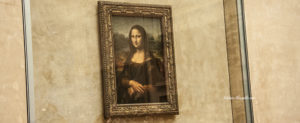Mona Lisa by Leonardo
(Italian Version below*)
Giorgio Vasari in the work ” Le Vite ” says that Leonardo took the portrait of Mona Lisa (Lisa Gherardini), the wife of Francesco del Giocondo and left him -imperfect- after 4 years of work.
The little historical information, clearly, contributed to the mystery, to the fame and charm of this portrait of a woman.
We remember that Vasari, however, never knew Leonardo or Lisa del Giocondo.
Leonardo made the small portrait (cm77x53) in a fairly large period of time, between 1503 and 1515, bringing it with him to the Castle of Cloux near Amboise, where he had moved to the service of King Francis I.
The work was located in the Castle at the time of Leonardo’s death, in 1519, and Salaì his follower was inherited who brought it to Milan.
In 1625 the painting was inventoried in the collection of Fontainebleau by Francesco I. Since that time it has always remained in French territory and is an integral part of the Louvre collections.
The pictorial quality (oil on poplar wood) is of the highest quality; especially for the psychological introspection of the portrayed subject and his unmatched mocking “smile”. Depending on how we look at it, it appears melancholy, cryptic, unreachably hermetic.
What is the mood of this woman in the end?
The three-quarter bust has a landscape in the background, the subject of endless studies: is it an imaginary place? It’s real? Much of the criticism tends towards a transposition of the areas between the countryside of Arezzo and the Val di Chiana, territories very familiar to Leonardo.
Leonardo’s genius makes a new type of perspective debut with the Mona Lisa, called aerial or “bird’s eye” and opens the way to the technique he will love most, the so-called nuanced. (In Italian we called it sfumato)
Thanks to the sfumato, Leonardo on one hand perfectly outlines the features of the face, but on the other hand, he manages to give her a margin of indeterminacy. Slight transitions of light accentuate the flow of emotions.
The main theme is not a simple portrait of a woman, but the will to express the flow of life: from human emotions to natural mutations.
InfoSite:Louvre
All rights reserved*
—————————————————————————————————————–
Giorgio Vasari nell’opera “ Le Vite “ racconta che Lionardo prese a fare per Francesco del Giocondo il ritratto di Monna Lisa (Lisa Gherardini) sua moglie e quattro anni penotovi lo lasciò imperfetto..
Le pochissime informazioni storiche che abbiamo hanno contribuito al mistero, alla fama ed al fascino di questo ritratto di donna.
Ricordiamo che Vasari, però, non conobbe mai nè Leonardo nè Lisa del Giocondo.
Leonardo realizzò il piccolo ritratto (cm77x53) in un lasso di tempo abbastanza ampio, tra il 1503 ed il 1515, portandolo con sè nel Castello di Cloux presso Amboise, dove si era trasferito al servizio del re Francesco I.
L’opera si trovava nel Castello al momento della morte di Leonardo, nel 1519, e fu ereditato dal suo allievo prediletto il Salaì, che la portò a Milano.
Nel 1625 il dipinto risulta inventariato nella collezione di Fontainebleau di Francesco I. Da quel momento è sempre rimasto in territorio francese ed è parte integrante delle collezioni del Louvre.
La qualità pittorica (olio su tavola di pioppo) è di altissima fattura; in particolar modo per l’introspezione psicologica del soggetto ritratto ed il suo ineguagliabile “sorriso” beffardo. A seconda di come la guardiamo ella ci appare malinconica, criptica, inarrivabilmente ermetica.
Qual’è alla fine lo stato d’animo di questa donna?
Il busto, di tre quarti, ha sullo sfondo un paesaggio, oggetto di interminabili studi: è un luogo immaginario? E’ reale? Buona parte della critica propende per una trasposizione delle zone tra le campagne di Arezzo e la Val di Chiana,territori molto familiari a Leonardo.
Il genio leonardesco fa esordire con la Gioconda un nuovo tipo di prospettiva, detta aerea o “a volo d’uccello” e apre la strada alla tecnica che amerà di più, il c.d. sfumato.
Grazie allo sfumato, Leonardo, da una parte delinea perfettamente i lineamenti del volto, ma dall’altra parte riesce a donarle un margine d’indeterminatezza. Lievi trapassi di luce accentuano il fluire delle emozioni.
Il tema principale non è un semplice ritratto di donna, ma la volontà di esprimere il fluire della vita: dalle emozioni umane alle mutazioni naturali.
InfoSite:Louvre
Sostieni la #culturachevince, aiuta la condivisione.


3 Replies to “Mona Lisa by Leonardo”
Complimenti per l’ottima descrizione, i riferimenti precisi e dettagliati e la competenza e professionalità. Continuerò a seguirti ed a leggere con interesse le tue pubblicazioni che arricchiscono le mie conoscenze.
Grazie mille, Barbara!
E’ un piacere trovarti sulle pagine del mio blog!
Non c’è cosa migliore che riuscire a trasferire attraverso queste descrizioni la passione che ho per il mondo dell’arte e della fotografia.
Molto bello.